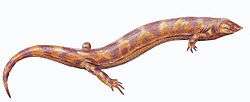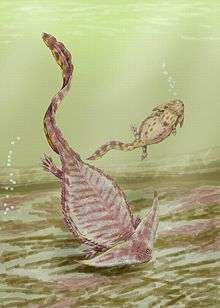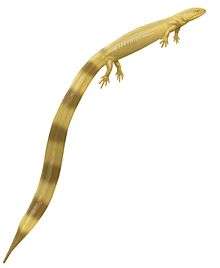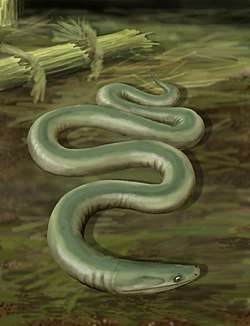Lysorophia
| Lysorophians | |
|---|---|
 | |
| Life restoration of Brachydectes newberryi | |
| Scientific classification | |
| Kingdom: | Animalia |
| Phylum: | Chordata |
| Clade: | Reptiliomorpha |
| Subclass: | †Lepospondyli |
| Order: | †Lysorophia Romer, 1930 |
| Family: | †Molgophidae Cope, 1875 |
| Genera | |
| Synonyms | |
Lysorophia is an order of aquatic Carboniferous and Permian tetrapods within the extinct subclass Lepospondyli. Lysorophians resembled small snakes, as their bodies are extremely elongate. There is a single family, the Molgophidae (previously known as Lysorophidae). Currently there are around five genera included within Lysorophia, although many may not be valid.[1]
Description
The skull is heavily built but with large lateral openings to accommodate jaw musculature, with small orbits restricted to the anterior edge of the large fenestrae. The intertemporal, supratemporal, postfrontal, and jugal bones of the skull have disappeared. The mandibles are short and robust with a small number of large triangular teeth. Although it was initially thought that the maxilla and premaxilla were freely movable, detailed anatomical studies show that this is not the case.[2] The braincase is extremely robust[1], suggesting that lysorophians may have engaged in headfirst burrowing.
The torso is very elongate, the limbs diminutive or absent, and the tail short. There are up to 99 pre-sacral (i.e. not including the hips and tail) vertebrae.
Based on morphology of the cranio-vertebral articulation and internal structure of the head, lysorophians are usually considered to be related to the Microsauria, although the pattern of bones of the skull is somewhat different.[3]
Distribution
Lysorophians are known mainly from the Pennsylvanian and Early Permian of North America.[4] In North America, fossils of lysorophians have been found from places such as the Chinle Formation in San Juan County, Utah and the Mazon Creek fossil beds in Grundy County, Illinois. Carboniferous lysorophians are also known from Europe, having been found from England and Ireland. Possible remains of a lysorophian have also been found from La Machine, France, although they may belong to an aïstopod.[3][5]
References
- 1 2 3 Pardo, Jason D.; Anderson, Jason S. (2016-08-26). "Cranial Morphology of the Carboniferous-Permian Tetrapod Brachydectes newberryi (Lepospondyli, Lysorophia): New Data from µCT". PLOS ONE. 11 (8): e0161823. doi:10.1371/journal.pone.0161823. ISSN 1932-6203. PMC 5001628. PMID 27563722.
- ↑ Bolt, John R.; Wassersug, Richard J. (1975). "Functional Morphology of the Skull in Lysorophus: A Snake-Like Paleozoic Amphibian (Lepospondyli)". Paleobiology. 1 (3): 320–332. JSTOR 2400372.
- 1 2 Wellstead, C. F. (1991). "Taxonomic revision of the Lysorophia, Permo-Carboniferous lepospondyl amphibians" (PDF). Bulletin of the American Museum of Natural History. 209: 1–90.
- ↑ Cannatella, D.C.; Vieites D.R.; ZHang P.; Wake M.H.; Wake D.B. (2009). "Amphibians (Lissamphibia)". In Hedges S.B. & Kumar S. The Timetree of Life. Oxford University Press. p. 354. ISBN 9780191608988. Retrieved 3 December 2012.
- ↑ Baird, D. (1964). "The aïstopod amphibians surveyed". Breviora. 206: 1–17.
General references
- Carroll, RL (1988), Vertebrate Paleontology and Evolution, WH Freeman & Co. p. 180
- von Zittel, K.A (1932), Textbook of Paleontology, C.R. Eastman (transl. and ed), 2nd edition, vol.2, p. 225-6, Macmillan & Co.
.png)




